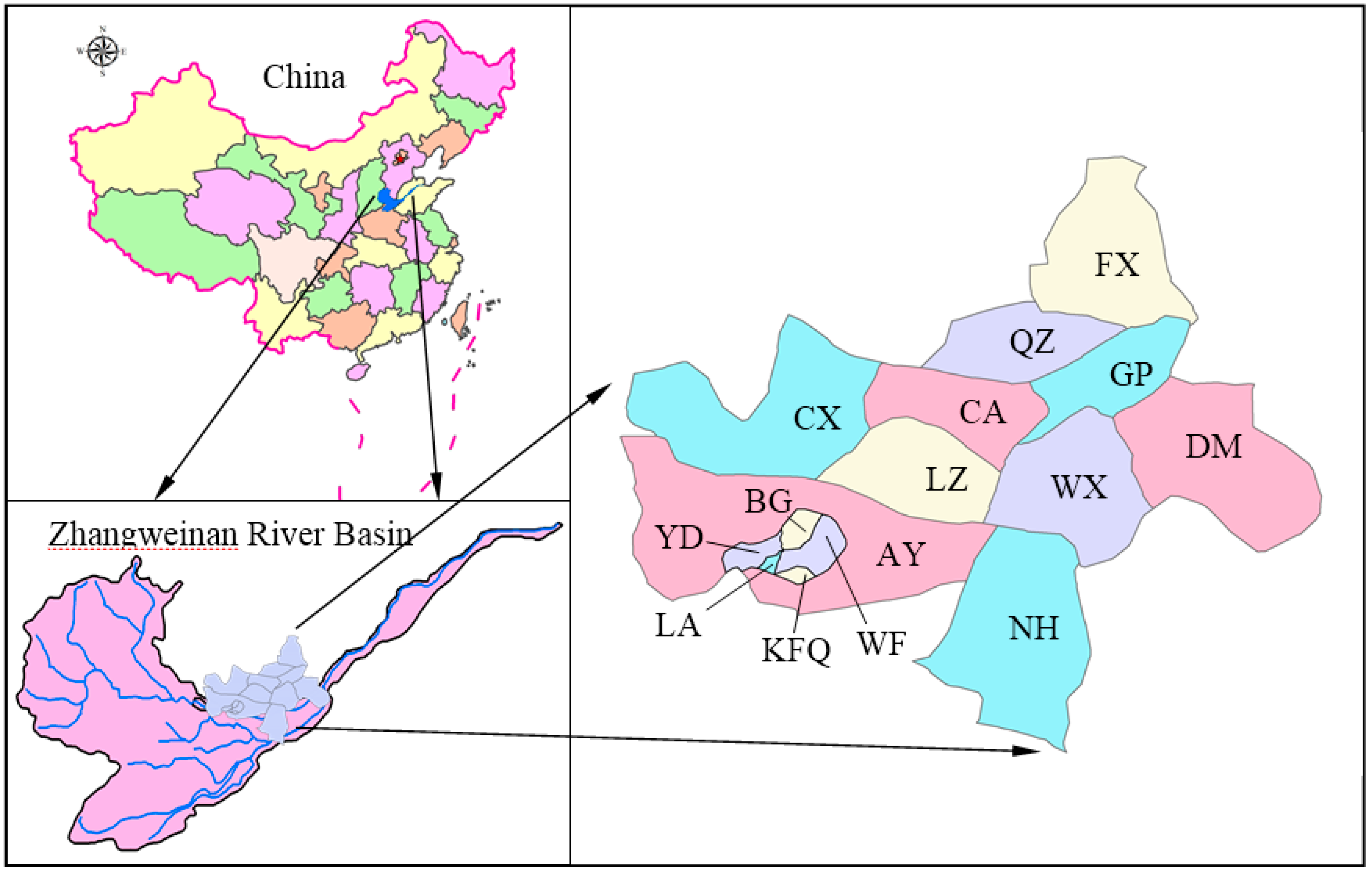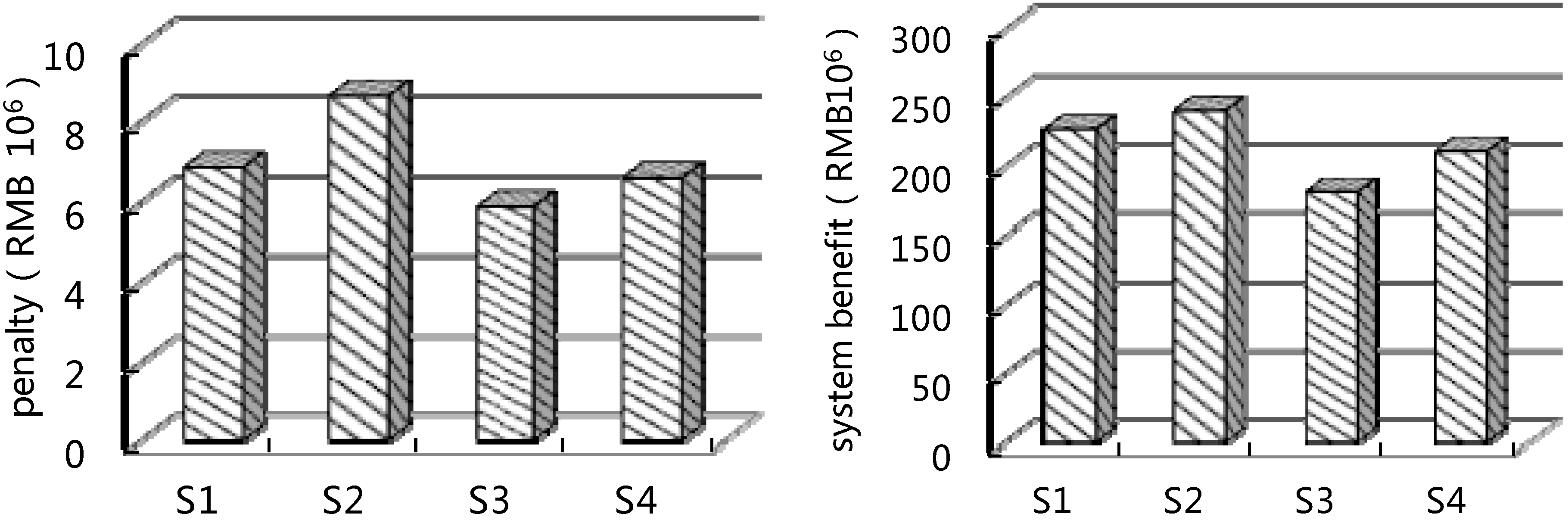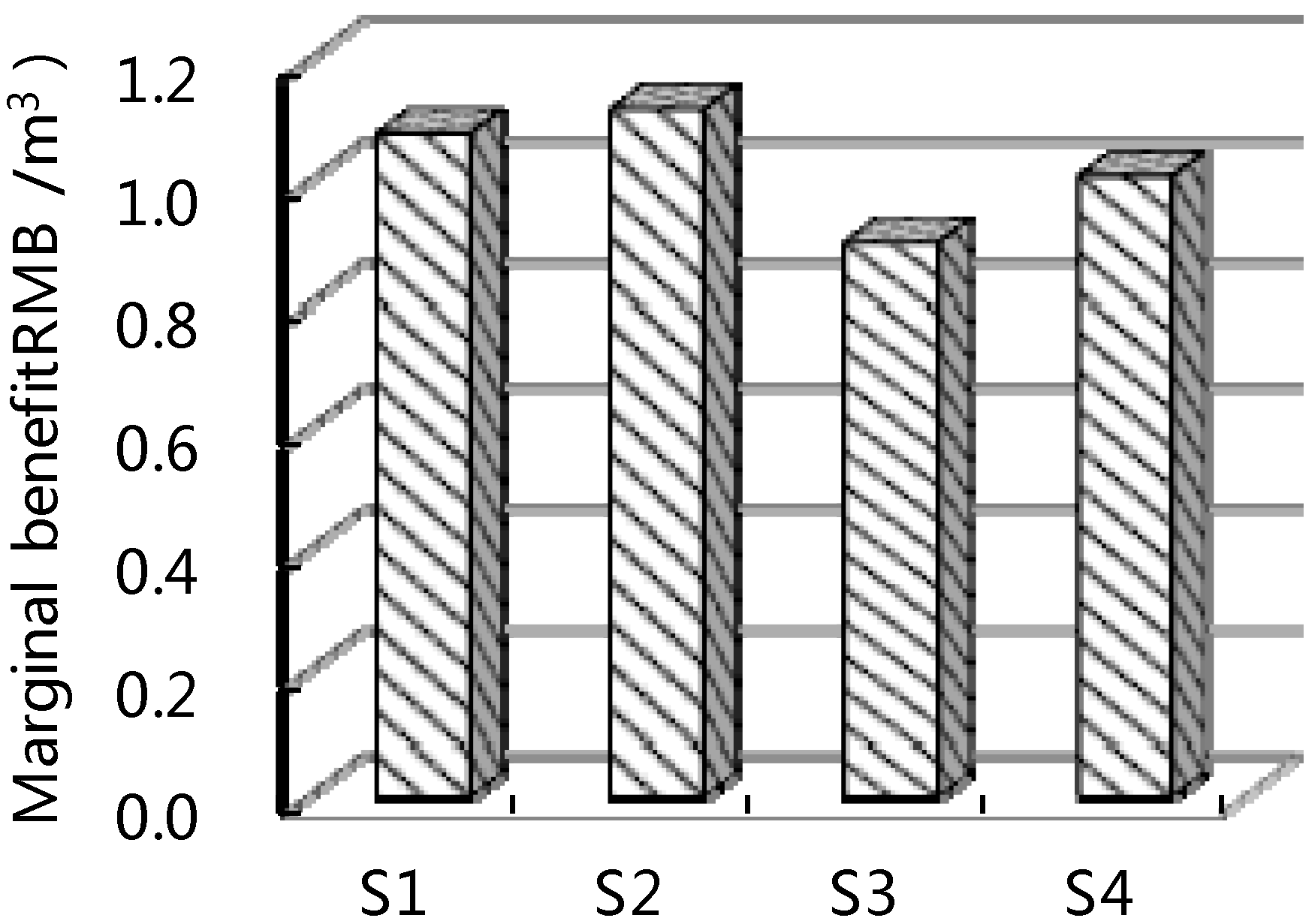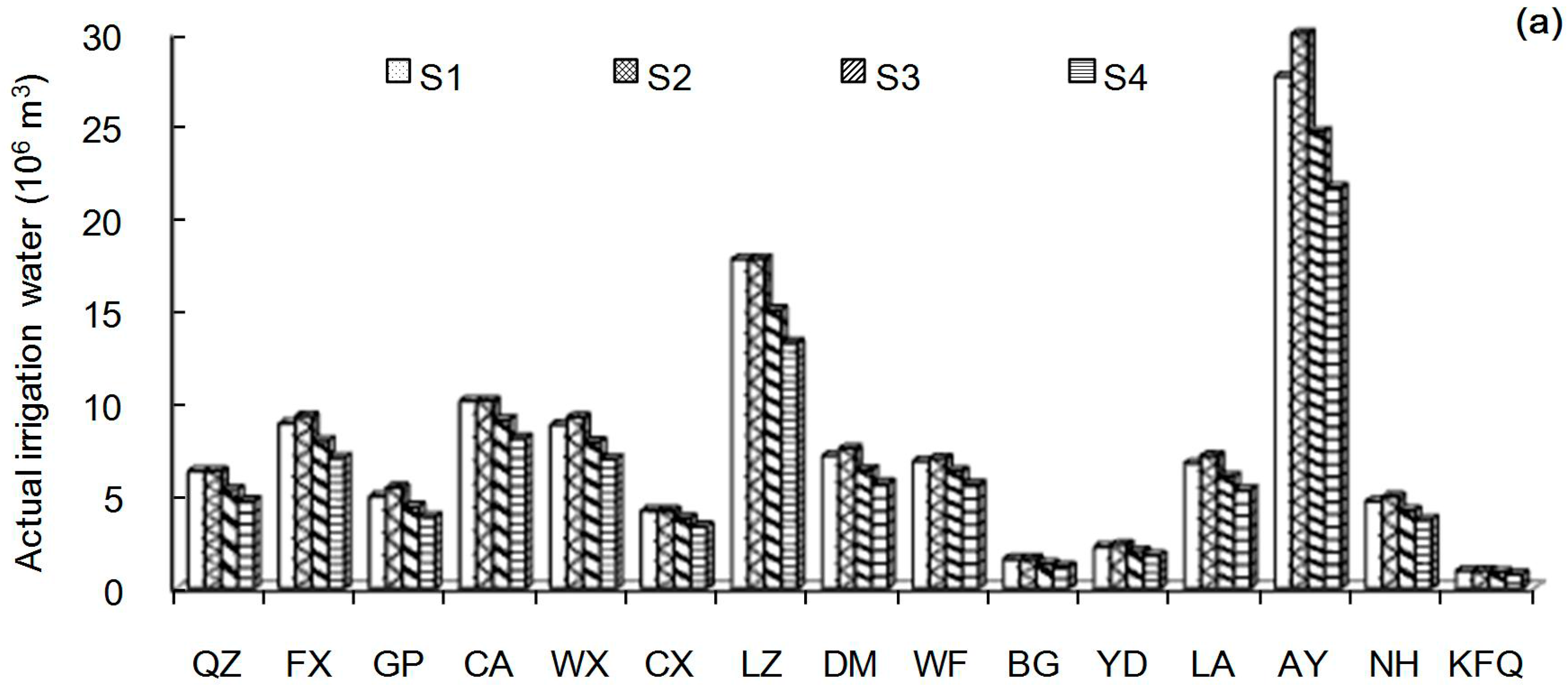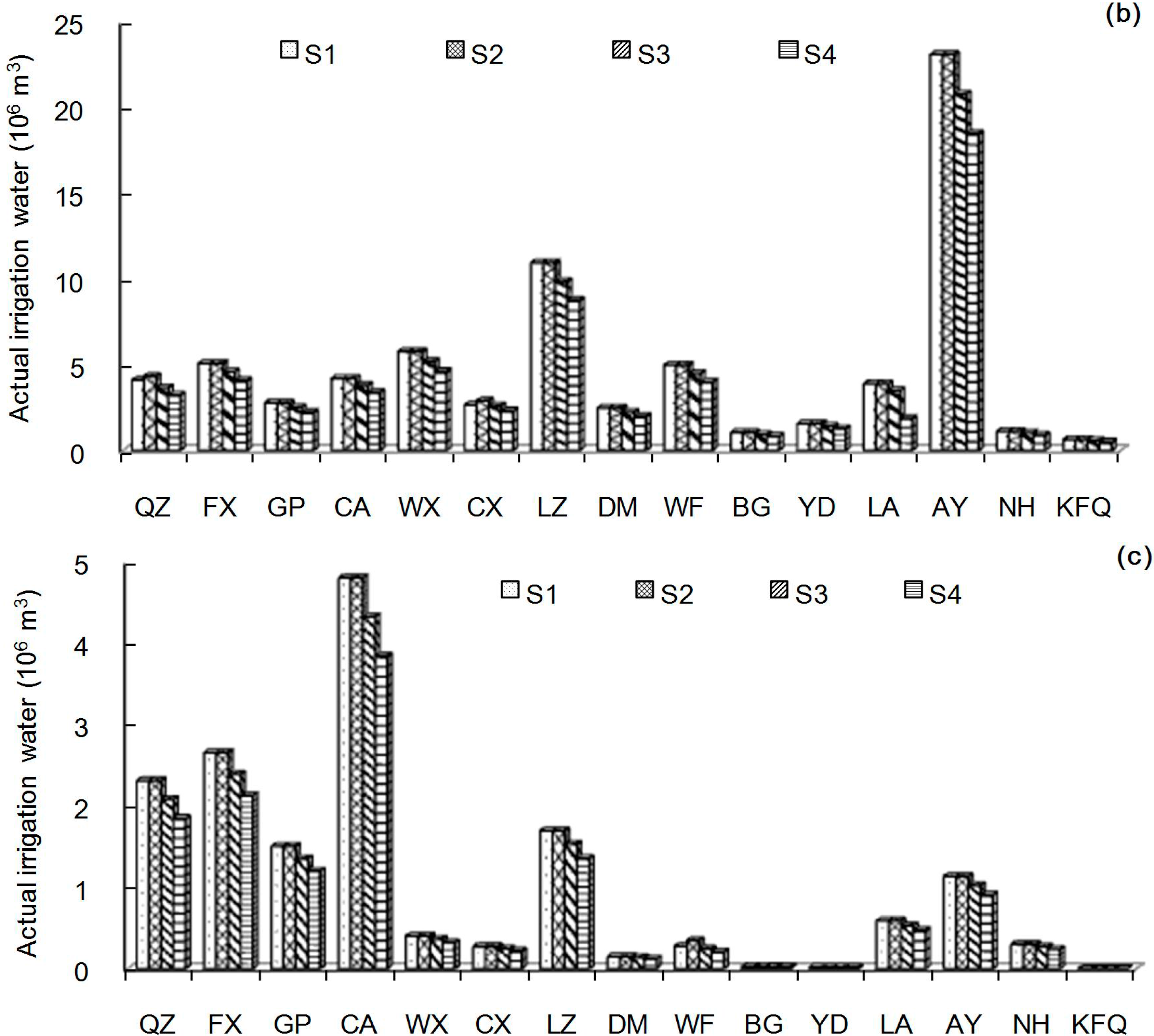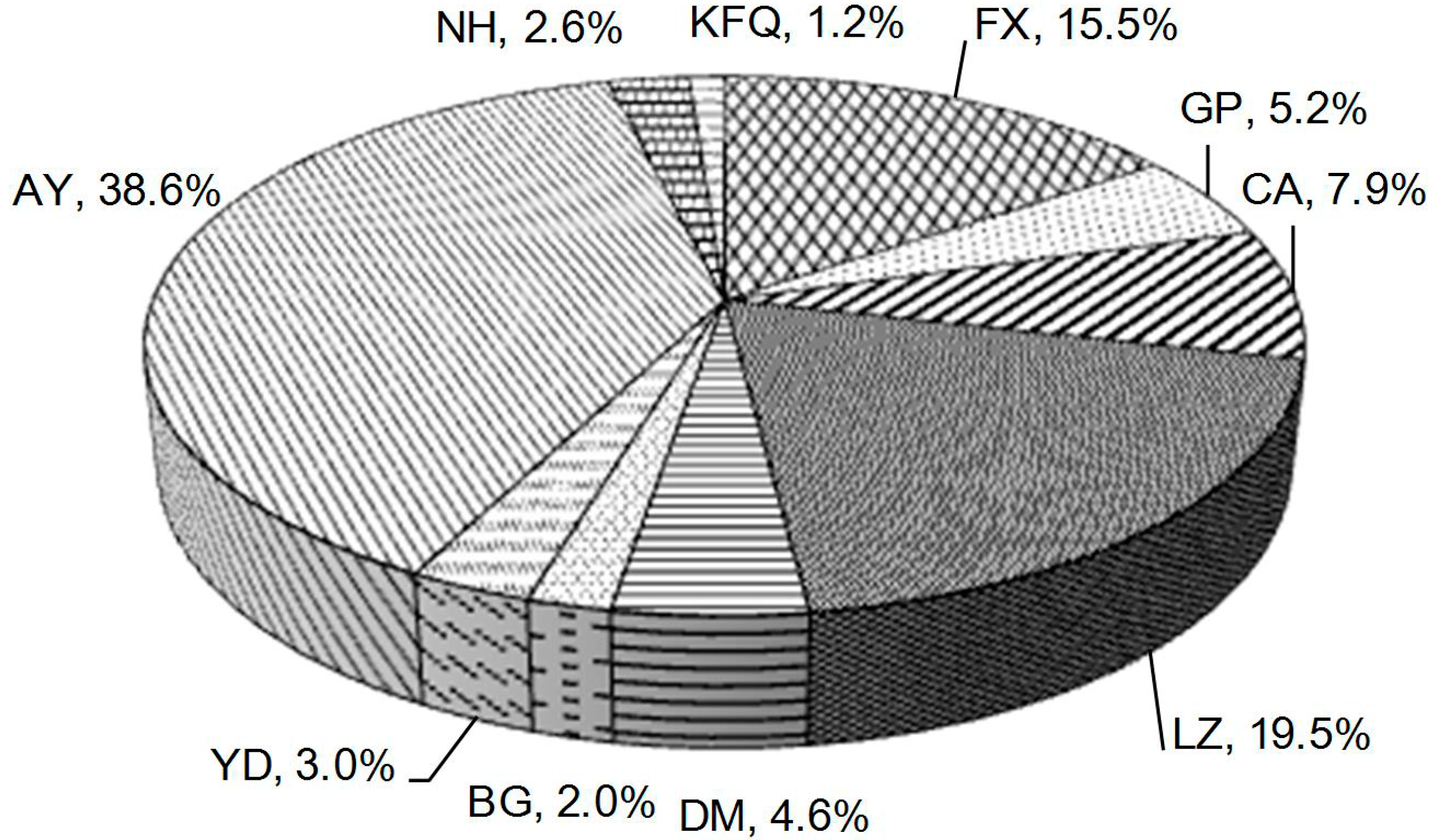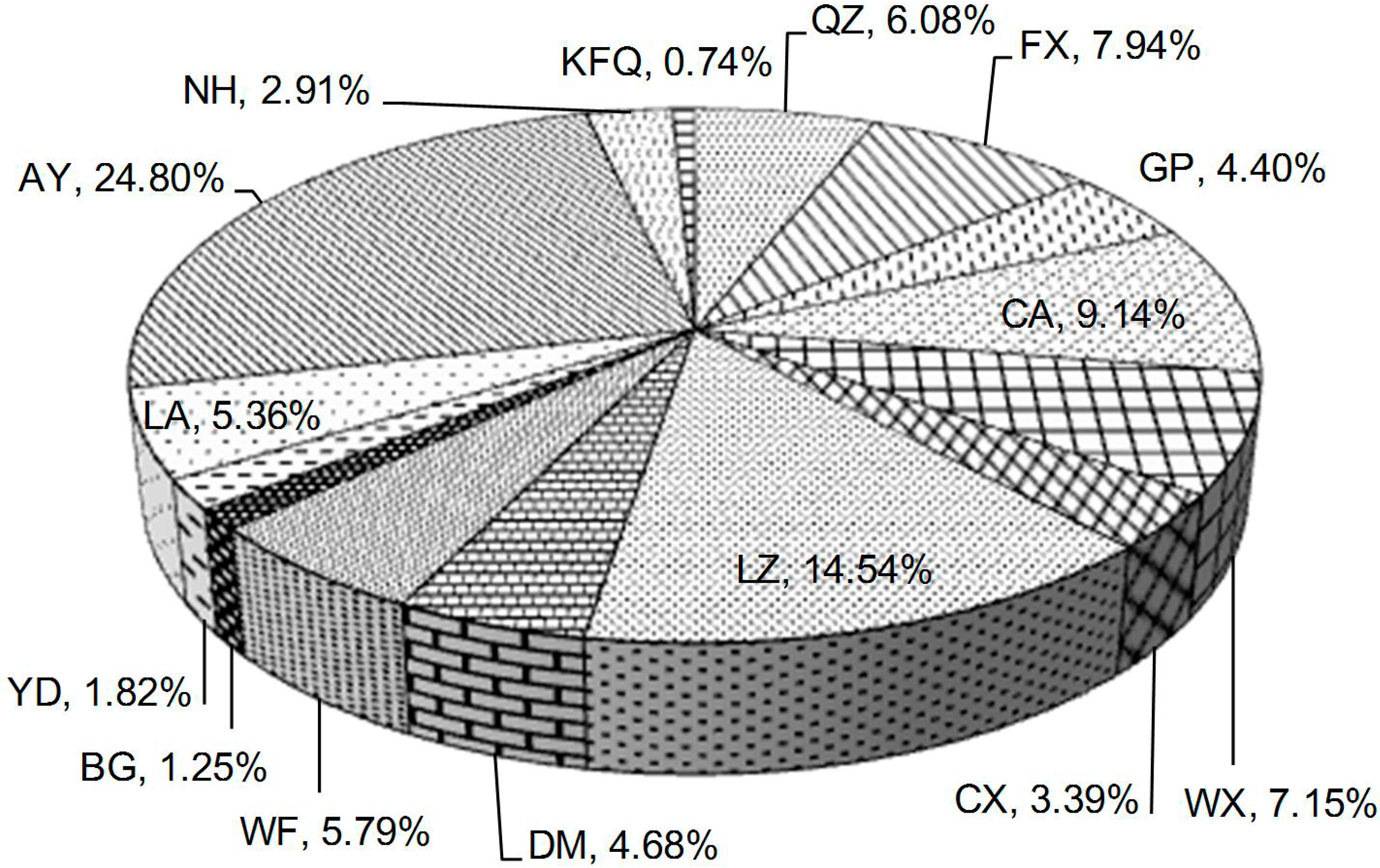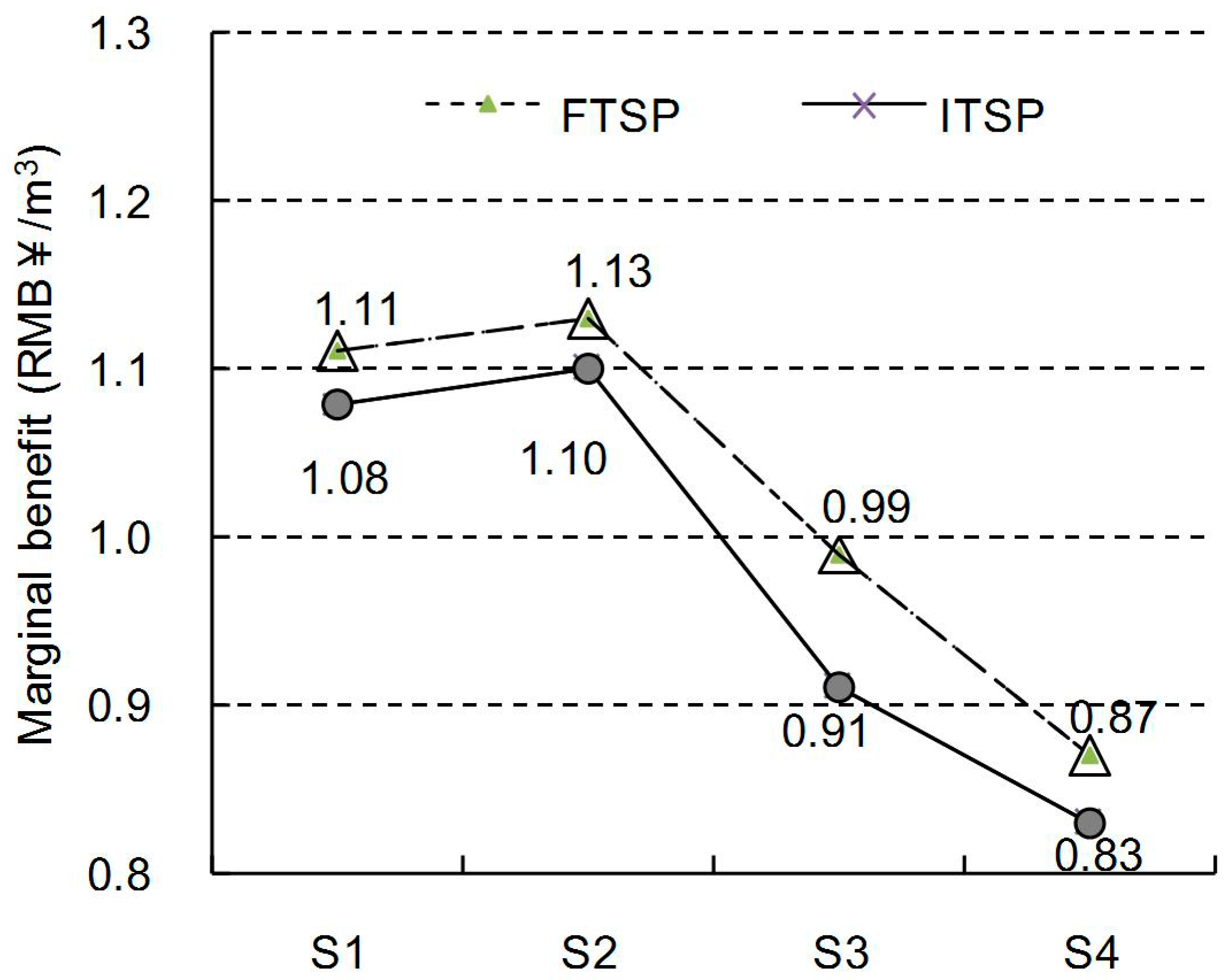1. Introduction
With speedy population growth and shift economic development, the constantly increasing demand for water in terms of sufficient quantities and satisfied qualities has forced researchers to draw optimal water resources management policies [
1,
2,
3]. When the demand for water has reached the limits of what the natural system can provide, water shortage may become a major obstacle to social and economic development for the region. As the biggest consumer of the limited water resources, irrigated agriculture uses about 70% of the world’s freshwater withdrawals, and causes salinity, drainage and environmental quality problems currently affecting many parts of the world [
4]. Therefore, it is a challenge for agricultural water resources managers to maintain sustainable development under situations of increasing water demand [
5]. Besides, agricultural water resources systems that are complex with uncertainties are often related to variations in the incompleteness or impreciseness of the observed information and spatial and temporal units. Consequently, the effective planning of agriculture water resources under such complexities and uncertainties is important for regional sustainable development in watershed systems.
With limited water resources for agriculture irrigation, managers tried to identify desired alternatives through raising irrigation productivity to realize optimal water allocation [
6,
7,
8]. Two-stage stochastic programming (TSP) is effective to deal with problems for which an analysis of policy scenarios is desired and the uncertainties can be expressed as probabilistic distributions. In TSP, an initial decision (first-stage decision) is made based on uncertain future events, then an action can be taken after the pre-regulated disclosure of random variables (second-stage decision) [
9]. This implies that TSP can minimize the expected costs of all applicable decisions taken over the two periods. TSP has been widely applied to water resources management over the past few decades [
10,
11,
12]. However, the conventional TSP models cannot optimize the system marginal benefit represented as system maximum output with per unit of input. In real-world agricultural water management problems, the ratio functions of profit and cost are often conflicted in nature, such that types of problems are inherently multiobjective fractional problems [
13].
Fractional programming (FP) is an effective tool to deal with optimization of ratio, where the objective is quotient of two functions, e.g., cost/time, cost/volume, or output/input [
14,
15]. It can compare objectives of different aspects directly through their original magnitudes and provide an unprejudiced measure of system efficiency. FP has widely been used in fields of resources management, finance, production and transportation [
16,
17]. The primary advantage of FP is the flexibility, but it has further advantages in balancing conflicting objectives, maximizing the system marginal benefit (
i.e., the marginal benefit of the resources is the gain from an increase or loss from a decrease in the consumption of that resource), comparing objectives of different aspects directly through their original magnitudes and providing an unprejudiced measure of system efficiency [
18]. Moreover, FP has been proved to be a natural way of approaching both economic and environmental criteria related to the systems’ sustainability. However, few studies are reported on the application of FP techniques to agricultural water resources management. In fact, fraction problems exist in agricultural water resources management systems, such as achieve maximum net benefit per unit of water quantity through effective water allocation policy, various targeted water demand associated with limited water resources. One major challenge of employing FP to agricultural water resources management systems is that FP has difficulties in handling stochastic uncertainty and reflecting the economic consequences of violating some overriding policies. Therefore, one potential approach for better accounting for uncertainty and optimizing ratio problems is to introduce TSP into the FP framework, leading to a two-stage stochastic fractional programming (TSFP) method.
The aim of this study is to develop such a TSFP method for planning agricultural water resources management system under uncertainty. TSFP can analyze policy scenarios when the pre-regulated targets are violated; it can also balance conflicting objectives and maximizing the system marginal benefit with per unit of input. Then, the developed TSFP method is applied to a real case of agricultural water resources management in the Zhangweinan River Basin, China, which faces severe water shortage problems due to precipitation temporal variation and population growth. The results obtained will be valuable for local decision makers to formulate desired decision alternatives and maintain sustainable development of the Zhangweinan River Basin.
2. Methodology
Two-stage stochastic programming (TSP) refers to a tradeoff between predefined strategies and the associated adaptive adjustments. In TSP, an initial first-stage decision must be made before the random variable is observed, then an action can be taken after the pre-regulated disclosure of second-stage decision [
19]. TSP cannot only handle uncertainties expressed as random variables but also provide an effective linkage between the pre-regulated policies and the associated economic implications caused by improper policies. Generally, a TSP model can be formulated as follows [
20]:
subject to
where
x is the first-stage decision variable made before the random variable
is observed, and
is the optimal value of the following nonlinear programming.
The TSP model cannot only deal with uncertainties expressed as random variables but also provide an effective linkage between the pre-regulated policies and the associated economic implications caused by improper policies [
21]. However, the TSP model could not measure system efficiency related to the system marginal benefit represented as the maximum output with per unit of input. FP is effective for dealing with the ratio optimization problem. A general FP problem can be formulated as follows [
22]:
subject to
where
is a auxiliary variables;
and
are column vectors with
and
components respectively;
and
are row vectors with
components; α and β are constants. According to Charnes and Cooper [
22] (pp. 181−186) if the denominator was constant in sign for all
on the feasible region, the FP model could be optimized by solving a linear programming problem.
Chadha [
23] (pp. 119−125) proved that, if (i)
for all feasible
; (ii) the objective function is continuously differentiable; and (iii) the feasible region is non-empty and bounded, primal problem (2) can be converted into the dual form:
subject to
where
is a column vector;
is a scalar; T over the matrix denotes the transpose of the matrix. Optimal solution (
) of Model (3) can be easily generated. Introducing
as the associated surplus column vector, and
.
Let
is an optimal solution to the primal problem Model (2) and
is the associated slack column vector, then
. According to complementary slackness theorem proposed by Chadha [
23] (pp. 119−125), Model (2) has the same optimal objective value as Model (3), the dual problem if and only if the following complement constraints are met:
Model (2) can be solved through dual problem Model (3) and its complement constraints Model (4). Then, introducing TSP into the FP framework. This leads to a two-stage stochastic fractional programming (TSFP) model as follows:
subject to
where
x is the first-stage decision variable made before the random variable
is observed. Let random variable
take discrete values
with a probability level
, where
. It is assumed that
Pl ˃ 0 and
. The expected value of the second-stage optimization problem can be expressed as:
Then, Model (5) can be reformulated as follows:
subject to
where
A is a auxiliary variables;
b is column vectors. Then Model (7) can be solved through dual Model (3) and its complement constraints Model (4).
3. Case Study
The Zhangweinan River Basin (112°–118°E, 35°–39°N) is a tributary of the Haihe River, China, with a drainage area of 37,700 km
2 [
24]. Precipitation varies largely among different seasons, the rain falls in spring, autumn and winter seasons, occupying 8%–16%, 13%–23% and 2% of the total precipitation per year, respectively [
25]. The Zhangweinan River Basin is one of the main food and cotton producing regions in north China, and faces a serious water shortage and sustainable development problem. The Yuecheng Reservoir is the largest reservoir in the Zhangweinan River Basin with controlled basin area of 18,100 km
2. The reservoir is important water storage for agricultural consumers both in Anyang and Handan cities, and supplies water for agricultural irrigation subareas through Zhangnan Channel in Anyang and Minyou Channel in Handan [
26]. The irrigation subareas are covered with cultivated crops, including maize, cotton, wheat, bean, rice, oilseed and vegetable. Maize, wheat and cotton are three major crop products. In this study, Yuecheng Reservoir irrigation subareas are chosen as the study areas, and the districts are divided into fifteen subareas according to the administrative division (
Figure 1).
Figure 1.
Schematic map of the study system (QZ, Quzhou county; FX, Feixiang county; GP, Guangping county; CA, Chengan county; WX, Weixian county; CX, Cixian county; LZ, Linzhang county; DM, Daming county; WF, Wenfeng district; BG, Beiguan district; YD, Yindu district; LA, Longan district; AY, Anyang county; NH, Neihuang county; KFQ, Kaifaqu district).
Figure 1.
Schematic map of the study system (QZ, Quzhou county; FX, Feixiang county; GP, Guangping county; CA, Chengan county; WX, Weixian county; CX, Cixian county; LZ, Linzhang county; DM, Daming county; WF, Wenfeng district; BG, Beiguan district; YD, Yindu district; LA, Longan district; AY, Anyang county; NH, Neihuang county; KFQ, Kaifaqu district).
Conflicts exist among these competing crops in different districts due to temporal variations of precipitation and increasing water demand. The amount of water availability per capita is about 212 m
3, which is only 7.42% of the average level in China, and it is far below the average level of 1000 m
3 per capita (
i.e., an internationally accepted definition for water scarcity) [
27]. Besides, temporal distribution of precipitation is uneven and the number of reservoirs and diversion channels increasing in the upper reaches of the river, the inflow of Yuecheng Reservoir is much less now than that of decades ago. Similar to most semi-arid and arid regions of the world, agriculture is highly dependent on the diversion of water resources for irrigation. Therefore, Zhangweinan river basin is one of the water shortage regions in China and drought often occurs.
Table 1 presents the surface water irrigation demand of each crop in each subarea [
26]. For ensuring the crops’ survival, the average water demand of each crop in each subarea is provided. For example, surface water irrigation demand for wheat in QZ is 6158.8 × 103 m
3 per year, while that for maize and cotton are 4204.2 × 103 m
3 and 2159.9 × 103 m
3, respectively.
Table 2 and
Table 3 present the data for net irrigation benefit and penalty of each crop in each subarea, which are estimated mainly based on the statistical yearbook of the Handan and Anyang, 2006–2014 and the water price for the Hebei Province and Henan Province. Values of net irrigation benefits and penalties are estimated according to different water users’ gross national product in different counties. For example, the net benefit of wheat in QZ is estimated by the gross amount of wheat and the total water demand (net benefit = gross amount of crops/total water demand). From 2006 to 2014, the gross amount of wheat in QZ is 4.9 × 10
6 RMB and the water demand is 7.0 × 10
6 m
3, therefore the net benefit of wheat in QZ is 0.7 RMB/m
3. Given irrigation target of each crop in each subarea is promised, if the irrigation demand is delivered, this will result in benefits. Otherwise, when the promised irrigation target is not satisfied, farmers are forced to use more ground water for irrigation, which will result in a reduction of crop production. For example, the penalties of wheat in QZ is estimated by the reduction of wheat and the water shortage (penalties = reduction of crops/water shortage). From 2006 to 2014, the reduction of wheat in QZ is 102.0 × 10
3 RMB and the water shortage is 103.0 × 10
3 m
3, therefore the penalties of wheat in QZ is 0.99 RMB/m
3. Since the inflow of Yuecheng Reservoir varies significantly among different years, three reservoir inflows are generated with probability distributions to approximate the stochastic inflow value, which are named as low, medium and high respectively. When inflow level is low (probability = 0.3) the water allocated for irrigation is 108.1 × 10
6 m
3; when inflow levels are medium (probability = 0.6) and high (probability = 0.1), the water allocated for irrigation are 127.3 × 10
6 m
3 and 302.7 × 10
6 m
3, respectively.
Table 1.
Surface water irrigation demand for each crop in each subarea.
Table 1.
Surface water irrigation demand for each crop in each subarea.
| Subarea | Wheat (103·m3) | Maize (103·m3) | Cotton (103·m3) |
|---|
| Quzhou county | 6158.8 | 4204.2 | 2159.9 |
| Feixiang county | 9082.5 | 4851.0 | 2541.0 |
| Guangping county | 5190.0 | 2598.8 | 1386.0 |
| Chengan county | 9783.2 | 4084.1 | 4504.5 |
| Weixian county | 9030.6 | 5509.4 | 367.3 |
| Cixian county | 4069.8 | 2766.2 | 245.4 |
| Linzhang county | 17,300 | 10,556.7 | 1540.8 |
| Daming county | 7343.9 | 2382.2 | 138.6 |
| Wenfeng district | 6928.7 | 4816.4 | 311.9 |
| Beiguan district | 1505.1 | 1004.9 | 20.8 |
| Yindu district | 2283.6 | 1507.3 | 13.9 |
| Longan district | 6954.6 | 3776.9 | 554.4 |
| Anyang county | 28,834.8 | 22,138.5 | 1088.6 |
| Neihuang county | 4818.6 | 1062.6 | 252.4 |
| Kaifaqu district | 908.3 | 589.1 | 0.0 |
Table 2.
Net irrigation benefits and penalties of each crop.
Table 2.
Net irrigation benefits and penalties of each crop.
| Subarea | Wheat (RMB ¥/m3) | Maize (RMB ¥/m3) | Cotton (RMB ¥/m3) |
|---|
| Net irrigation benefit when water demand is satisfied |
| Quzhou county | 0.70 | 1.30 | 1.16 |
| Feixiang county | 0.76 | 1.63 | 1.50 |
| Guangping county | 0.75 | 1.58 | 1.13 |
| Chengan county | 0.82 | 1.66 | 1.18 |
| Weixian county | 0.72 | 1.29 | 1.09 |
| Cixian county | 0.71 | 1.32 | 1.14 |
| Linzhang county | 0.82 | 1.67 | 1.17 |
| Daming county | 0.74 | 1.42 | 0.86 |
| Wenfeng district | 0.76 | 1.29 | 0.63 |
| Beiguan district | 0.79 | 1.48 | 1.23 |
| Yindu district | 0.76 | 1.55 | 1.46 |
| Longan district | 0.44 | 1.10 | 0.79 |
| Anyang county | 0.78 | 1.38 | 0.74 |
| Neihuang county | 0.74 | 1.44 | 1.21 |
| Kaifaqu district | 0.83 | 1.43 | 0.00 |
| Penalty when water is not delivered |
| Quzhou county | 0.99 | 1.62 | 1.70 |
| Feixiang county | 1.05 | 1.99 | 2.13 |
| Guangping county | 1.04 | 1.93 | 1.65 |
| Chengan county | 1.12 | 2.02 | 1.70 |
| Weixian county | 1.01 | 1.62 | 1.60 |
| Cixian county | 0.99 | 1.65 | 1.68 |
| Linzhang county | 1.12 | 2.03 | 1.70 |
| Daming county | 1.03 | 1.75 | 1.33 |
| Wenfeng district | 1.05 | 1.61 | 1.06 |
| Beiguan district | 1.10 | 1.84 | 1.81 |
| Yindu district | 1.05 | 1.91 | 2.13 |
| Longan district | 0.72 | 1.43 | 1.28 |
| Anyang county | 1.08 | 1.71 | 1.23 |
| Neihuang county | 1.03 | 1.78 | 1.81 |
| Kaifaqu district | 1.14 | 1.77 | 1.81 |
Table 3.
Actual irrigation water from TSFP model.
Table 3.
Actual irrigation water from TSFP model.
| Subarea | Wheat (103·m3) | Maize (103·m3) | Cotton (103·m3) |
|---|
| Quzhou county | 6.33 | 4.32 | 2.31 |
| Feixiang county | 9.27 | 5.08 | 2.66 |
| Guangping county | 5.43 | 2.77 | 1.50 |
| Chengan county | 10.12 | 4.20 | 4.80 |
| Weixian county | 9.24 | 5.75 | 0.40 |
| Cixian county | 4.18 | 2.89 | 0.27 |
| Linzhang county | 17.78 | 10.95 | 1.70 |
| Daming county | 7.53 | 2.48 | 0.15 |
| Wenfeng district | 7.00 | 4.99 | 0.35 |
| Beiguan district | 1.56 | 1.04 | 0.03 |
| Yindu district | 2.33 | 1.56 | 0.02 |
| Longan district | 7.16 | 3.88 | 0.59 |
| Anyang county | 29.99 | 23.10 | 1.14 |
| Neihuang county | 4.95 | 1.12 | 0.30 |
| Kaifaqu district | 0.93 | 0.62 | 0.00 |
The planners desire optimal agricultural water allocation plans of Yuecheng Reservoir, which could achieve regional sustainable development and maximized system benefit. With the increasing concerns of water resources allocation and environmental protection, it is lead to the challenge of how to allocate the water resources more efficiently. Therefore, a sound agricultural water-resources management planning with limited water resources is important for not only agricultural production but also sustainable development in the basin. Consider the case in which a water manager is charged with delivering water from Yuecheng Reservoir to the fifteen agricultural irrigation subareas. Three main crops, maize, wheat and cotton are considered as water users. The objective is to achieve maximum net benefit per unit of water quantity through effective water allocation policy. The decision variables represent water flows from Yuecheng Reservoir to the fifteen irrigation subareas. The constraints involve all the relationships between the decision variables and the water supply conditions. Therefore, a two-stage stochastic fractional programming (TSFP) model for agricultural water resources management can be formulated as follows:
subject to
where
f is the expected net system benefit (RMB);
i is the subarea,
i = 1, 2, …, 15 (QZ, FX, GP, CA, WX, CX, LZ, DM, WF, BG, YD, LA, AY, NH, KGQ);
j is the index for crop
j = 1, 2, 3 (wheat, maize, cotton); NB
ij is the net irrigation benefit for crop j in subarea
i per unit of surface water allocated (RMB/m
3) which equivalent to
c in Model (7); QT
ij is the fixed allocation target for water that is promised to user
i (m
3) which equivalent to
x in Model (7);
k is the inflow level of the Yuecheng Reservoir,
k = 1, 2, 3 (low, medium, high);
pk is the probability of inflow
k equivalent to
pl in Model (7); C
ij is the reduction of net benefit (penalty) for crop
j in subarea
i when per unit of surface water not delivered (RMB/m
3); QD
ijk is the amount by which water-allocation target QT
ij is not met when the seasonal flow is QW
k (m
3), and it is the decision variables which equivalent to in Model (7); QW
k is the water available for irrigation in Yuecheng Reservoir under inflow
k (m
3).
4. Results and Discussion
One of the main advantages of the TSFP model is its capability to incorporating penalties attributed to the violation of the predefined policies through the first-stage variables (
QTij). Given an irrigation target that is promised to the agricultural water users, if the target is satisfied, it could result in system benefit. However, when the promised irrigation target could not satisfy the water demand, farmers are forced to use more ground water for irrigation to minimize the reduction of system benefit. Therefore, in this study, four scenarios were examined based on different irrigation targets:
In scenario 1, the irrigation target will approach their optimized irrigation target (QTij opt) through solving the TSFP model.
Scenario 2 is based on an aggressive policy for water diversion the irrigation target will approach their upper bounds (QTij = ). This scenario is applicable when the manager is optimistic that the irrigation target may be sufficient for all of the water users.
Scenario 3 corresponds to a situation when the irrigation target will approach their lower bounds (QTij = ), in which the manager is conservative for water-resources availability.
In scenario 4, the irrigation target approach their average value (QTij = ( + )/2). This scenario represents the manager is of neutral attitude to water resources availability.
Results have been obtained through solving the TSFP model.
Figure 2 presents the penalty, net system benefit, and marginal benefit under different scenarios. The system would achieve the highest system benefit under scenario 2 (
i.e., 241.4 × 10
6 RMB), while the system would obtain the lowest system benefit under scenario 3 (
i.e., 181.7 × 10
6 RMB); in comparison, under scenarios 1 and 4, the system benefit would be 227.7 × 10
6 and 211.6 × 10
6 RMB, respectively. Scenario 2 would achieve the highest penalty (
i.e., 8.6 × 10
6 RMB); scenario 3 would achieve the lowest penalty (
i.e., 5.9 × 10
6 RMB). Marginal benefit under the four scenarios would be 1.08, 1.12, 0.9 and 1.01 RMB/m
3, respectively, showing that the marginal benefit under scenario 2 would achieve the highest value. According to
Figure 2, when the irrigation targets approach their upper bounds under scenario 2, high system benefit would be obtained, but a high penalty might have to be paid when the promised water is not delivered. However, when the irrigation targets reach their lower bounds under scenario 3, a lower system benefit would be achieved; at the same time, a lower risk of violating the promised irrigation target and a lower recourse cost if the water demands are not satisfied. System net benefit
(NBij − Cij) and penalty (
Cij) under scenario 2 are higher than the other scenarios, it shows that scenario 2 maximized the system benefit and irrigation target.
Figure 2.
Penalty, system benefit and marginal benefit of TSFP model under different scenarios. (Symbols “S1”, “S2”, “S3” and “S4” denote “scenario 1”, “scenario 2”, “scenario 3” and “scenario 4”, respectively; TSFP = two-stage stochastic fractional programming.)
Figure 2.
Penalty, system benefit and marginal benefit of TSFP model under different scenarios. (Symbols “S1”, “S2”, “S3” and “S4” denote “scenario 1”, “scenario 2”, “scenario 3” and “scenario 4”, respectively; TSFP = two-stage stochastic fractional programming.)
The results also demonstrate that different pre-regulating irrigation target policies would lead to different system benefit and target-violation risk.
Table 3 presents the actual irrigation water (
QTij − QDijk) of the three crops in the study area (scenario 1). The actual irrigation water of wheat would be 6.3 × 10
6 m
3 in QZ, 9.3 × 10
6 m
3 in FX, 5.43 × 10
6 m
3 in GP and 0.9 × 10
6 m
3 in KFQ, and the actual irrigation water of maize would be 4.2 × 10
6 m
3 in CA, 5.8 × 10
6 m
3 in WX, 2.9 × 10
6 m
3 in CX and 11.0 × 10
6 m
3 in LZ. The results indicate that wheat and maize actual irrigation water could not satisfy the water demand, and cotton optimized irrigation could satisfy the water demand expect for WF. This occurs due to the net irrigation benefit of cotton is larger than wheat and maize, and the water for cotton in the fifteen irrigation subareas is administratively guaranteed firstly, while that for wheat and maize would be delivered after satisfying the cotton water demand in the management of the farmer. Deficits would occur if the available water resources from the reservoir could not meet the wheat and maize irrigation demands. The actual irrigation water of three crops is presented in
Figure 3. For example, optimized irrigation target of AY is 54.2 × 10
6 m
3, and optimized irrigation target of KFQ is 30.4 × 10
6 m
3.
Figure 3.
Actual irrigation water of the three crops from TSFP model ((a) wheat; (b) maize; (c) cotton; QZ, Quzhou county; FX, Feixiang county; GP, Guangping county; CA, Chengan county; WX, Weixian county; CX, Cixian county; LZ, Linzhang county; DM, Daming county; WF, Wenfeng district; BG, Beiguan district; YD, Yindu district; LA, Longan district; AY, Anyang county; NH, Neihuang county; KFQ, Kaifaqu distric).
Figure 3.
Actual irrigation water of the three crops from TSFP model ((a) wheat; (b) maize; (c) cotton; QZ, Quzhou county; FX, Feixiang county; GP, Guangping county; CA, Chengan county; WX, Weixian county; CX, Cixian county; LZ, Linzhang county; DM, Daming county; WF, Wenfeng district; BG, Beiguan district; YD, Yindu district; LA, Longan district; AY, Anyang county; NH, Neihuang county; KFQ, Kaifaqu distric).
Actual irrigation water (
QTij − QDijk) under different scenarios can be generated by letting
QTij have different values.
Figure 3 presents the solutions for actual irrigation water of the three crops under different scenarios. Water allocation of wheat in AY and LZ under four scenarios is higher than the other subareas due to the relatively higher water demands. For example, the planned wheat irrigation area is 8667 ha in AY and 5140 ha in KFQ. However, the planned wheat irrigation area is 270 ha in KFQ which is much lower than AY. Actual irrigation water of cotton in CA, FX and QZ under four scenarios are higher than the other subareas. The reason is that the population density of these four subareas is larger than the other subareas, and offers enough labor force for the cotton implantation.
Yuecheng Reservoir supplies water for agricultural irrigation subareas through Zhangnan Channel in Anyang and Minyou Channel in Handan. Therefore, the water allocation rate of the two channels is important for the water irrigation of each crop in each subarea. The existing water allocation rate of Minyou Channel and Zhangnan Channel are 60% and 40%, respectively. Water allocation rate of the two channels are different under different scenarios. In scenario 1, the optimized water allocation rate of Minyou Channel and Zhangnan Channel are 57.3% and 42.7, respectively; in scenario 2, the water allocation rate of Minyou Channel and Zhangnan Channel are 52.2% and 47.8%, which indicate that all the water is almost equally allocated; in scenario 4, the optimized water allocation rate of Minyou Channel and Zhangnan Channel are 67.7% and 32.3%, respectively. Yuecheng Reservoir water allocation rate of the two channels are changes with the irrigation target compared with the existed water resources allocation plan. The solution from TSFP model provides more choices for the managers, and adapts the changes in the actual agricultural water resources demand.
Actual irrigation water under low and high inflows of the Yuecheng Reservoir are presented in
Figure 4 and
Figure 5. Results indicate that water shortage would be generated if the pre-regulated target could not be satisfied. Under such a situation, the actual water allocation would be different between the pre-regulated target and the water demand, which indicates that different inflow levels would result in varied water-allocation patterns. For example, under low inflow level (K1), water shortage would definitely occur and no water would be allocated to subareas QZ, WX, CX, WF and LA. AY, LZ and FX are main water users of Yuecheng Reservoir, total water allocated to the three subareas is 38.6%, 19.5% and 15.5%, respectively, as shown in
Figure 5. Under high inflow level (K3), all the fifteen subareas have allocated water flow, AY, LZ and FX are main water users of Yuecheng Reservoir. The total water allocated to AY, LZ and FX is 24.8% 14.5%, and 19.5% respectively, as shown in
Figure 6. Each allocated water flow is the different between the pre-regulated target and the water shortage under a given stream condition, which indicate that different inflow levels would result in varied water-allocation patterns. Due to temporal distribution of precipitation is uneven more than 80% of the total annual precipitation falls from May to September. Therefore, when inflow is low, the shortage would be strengthened, farmers would have to obtain water from underground sources to satisfy crop production.
Figure 4.
Actual irrigation water under low inflow levels of the Yuecheng Reservoir (QZ, Quzhou county; FX, Feixiang county; GP, Guangping county; CA, Chengan county; WX, Weixian county; CX, Cixian county; LZ, Linzhang county; DM, Daming county; WF, Wenfeng district; BG, Beiguan district; YD, Yindu district; LA, Longan district; AY, Anyang county; NH, Neihuang county; KFQ, Kaifaqu distric).
Figure 4.
Actual irrigation water under low inflow levels of the Yuecheng Reservoir (QZ, Quzhou county; FX, Feixiang county; GP, Guangping county; CA, Chengan county; WX, Weixian county; CX, Cixian county; LZ, Linzhang county; DM, Daming county; WF, Wenfeng district; BG, Beiguan district; YD, Yindu district; LA, Longan district; AY, Anyang county; NH, Neihuang county; KFQ, Kaifaqu distric).
Figure 5.
Actual irrigation water under high inflow levels of the Yuecheng Reservoir (QZ, Quzhou county; FX, Feixiang county; GP, Guangping county; CA, Chengan county; WX, Weixian county; CX, Cixian county; LZ, Linzhang county; DM, Daming county; WF, Wenfeng district; BG, Beiguan district; YD, Yindu district; LA, Longan district; AY, Anyang county; NH, Neihuang county; KFQ, Kaifaqu distric).
Figure 5.
Actual irrigation water under high inflow levels of the Yuecheng Reservoir (QZ, Quzhou county; FX, Feixiang county; GP, Guangping county; CA, Chengan county; WX, Weixian county; CX, Cixian county; LZ, Linzhang county; DM, Daming county; WF, Wenfeng district; BG, Beiguan district; YD, Yindu district; LA, Longan district; AY, Anyang county; NH, Neihuang county; KFQ, Kaifaqu distric).
When the water managers aim to a maximized system benefit without considering the unit water allocation benefit, the study problem can be formulated as an intevral two-stage stochastic programming (ITSP) model [
19].
Figure 6 presents the comparison of optimized water allocation to each user from TSFP and ITSP under different inflow levels of the Yuecheng Reservoir. System benefit from the TSFP model is higher than that from the ITSP model. For example, under low water inflow (K1), the system net benefits (
NBij − Cij) from TSFP and ITSP (upper bound) are 147.0 × 10
6 RMB and 138.0 × 10
6 RMB, respectively. Similarly, under high water inflow (K3), system benefit resulting from TSFP model would be 240.0 × 10
6 RMB, and 224.0 × 10
6 RMB from ITSP model. As regards the optimized irrigation target from the two models, cotton irrigation targets from TSFP model under three inflow levels are higher than that from the ITSP model, as shown in
Figure 7. This is due to the fact that wheat and maize cost more water but result in a lower system benefit compared with cotton. Water can thus be transferred to its most valuable users with the TSFP model. Therefore, TSFP model improves the water allocation efficiency.
Furthermore, the TSFP model could maximize marginal benefit of limit water resources.
Figure 7 compares the results of marginal benefits from TSFP and ITSP models under different scenarios. It indicates that under each scenario the solutions obtained from TSFP lead to significant higher than the ITSP model. For example; under scenario 1 the system marginal benefit would be 1.11 RMB/m
3 from the TSFP model and 1.08 RMB/m
3 from the ITSP model; under scenario 2 the system marginal benefit would be 1.13 RMB/m
3 from the TSFP model and 1.10 RMB/m
3 from the ITSP model. Obviously; the TSFP model has a higher marginal benefit than the ITSP model under any scenarios as presented in
Figure 7 Generally, the TSFP model could directly calculate the marginal benefit and take the marginal benefit goal as the objective function. Thus, the TSFP model could more effectively in addressing the sustainable water management problem and providing more information regarding tradeoffs between multiple input factors and system benefit in the Yuecheng reservoir water resources management system. This would allow the managers to make a water resources management plan with the consideration of maximized marginal benefit.
Figure 6.
Comparison of actual irrigation water to each user from TSFP and ITSP under different inflow levels of the Yuecheng Reservoir [TSFP = two-stage stochastic fractional programming; ITSP = Interval Two-stage stochastic programming].
Figure 6.
Comparison of actual irrigation water to each user from TSFP and ITSP under different inflow levels of the Yuecheng Reservoir [TSFP = two-stage stochastic fractional programming; ITSP = Interval Two-stage stochastic programming].
Figure 7.
Optimized marginal benefit through TSFP and ITSP models under different scenarios.
Figure 7.
Optimized marginal benefit through TSFP and ITSP models under different scenarios.
5. Conclusions
In this study, a two-stage stochastic fractional programming (TSFP) method has been developed for planning agricultural water resources management under uncertainty. The TSFP method can solve ratio optimization problems associated with stochastic information and reflect the marginal benefit. The developed TSFP model has the following advantages over the other optimization methods: (1) it can deal with marginal problem and maximized the system marginal benefit; (2) it provides an effective linkage between conflicting economic benefits and the associated penalties attributed to the violation of the predefined policies; (3) it provides optimized solutions under different inflow levels with four irrigation scenarios.
The developed TSFP model has been applied to a real agricultural water resources management system planning in the Zhangweinan River Basin, China. The objective is to maximize the marginal system benefits subject to the environmental requirements under uncertainty over the planning horizon. Fifteen subareas were considered, and three major crops were considered as agricultural water consumers. Optimized water allocation for water user activities under four irrigation scenarios have been generated by solving TSFP model. System benefit, water allocation, and marginal benefit under different scenarios have been analyzed, which indicate that different policies for water system managers to identify desired water allocation options under various water supply policies when considering unit water efficiency.
It is indicated that the TSFP model can maximize the system marginal benefit. Based on the optimized solutions, a variety of surface water allocation plans can be generated through adjusting continuously within their solutions. Correspondingly, the specific suggestions to the authorities can be summarized as follows: (1) Different pre-regulating irrigation target policies lead to different system benefits and target-violation risks, and scenario 1 balanced the system benefit and irrigation target violating risk; (2) Optimized wheat irrigation target in AY and LZ under 4 scenarios is higher than the other subareas due to the relatively higher water demands, and optimized cotton irrigation targets in CA, FX and QZ under 4 scenarios are higher than the other subareas due to an adequate labor force; (3) In scenario 1, the optimized water allocation rate of Minyou Channel and Zhangnan Channel are 57.3% and 42.7%, which adapts to the changes in the actual agricultural water resources management problem; (4) Under each scenario the solutions obtained from TSFP lead to significant higher than the ITSP model; (5) The solution from the TSFP model provides more choices for the managers, and adapts the changes in the actual agricultural water resources demand. The above analysis could help the water managers identify desired water allocation options under various water supply policies when considering unit water benefit of the Yuecheng reservoir. In fact, local decision makers are looking forward to having multiple types of decision schemes, such as a set of conservative solutions with lower risks and optimistic solutions with higher risks, such that they can make their decisions according to their understanding and preference in trade-off analysis between system economy and reliability. Generally, the proposed model could offer a spectrum of decision alternatives to decision makers in dealing with Yuecheng reservoir resources management, in consideration of intrinsically complex uncertainties and Zhangweinan River Basin water resources sustainable development.
The results indicate that the developed TSFP model could effectively deal with problems associated with stochastic information and reflect the marginal benefit. However, there are still some extensive research works to be done. For example, underground water plays an important role for agricultural irrigation. It is desired to tackle the issue of agricultural water management from both surface and underground sectors. Moreover, water management consists of not only agricultural water management, but also municipal, industrial and ecological water management. Consequently, the integration of surface and underground water as well as the incorporation of industrial and municipal water uses would be interesting topics that deserve future research.
